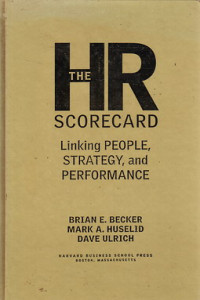Text
The HR scorecard : linking people, strategy, and performance
PROFESSIONALS IN HUMAN RESOURCES are increasingly challenged to take a more strategic perspective regarding their role in the organiza¬tion. We find that as HR professionals respond to this challenge, measur¬ing HR's performance and its contribution to the firm's performance consistently emerges as a key theme. This should come as no surprise. The last decade has been highlighted by an ever-increasing appreciation for the value of intangible assets and the associated trend toward strate¬gic performance measurement systems such as Robert Kaplan and David Norton's Balanced Scorecard. New opportunities for HR professionals, new demands for HR's accountability, and new perspectives on measur¬ing organizational performance have all converged This book is intended to guide HR managers through the challenge of these converging trends. It is based on more than a decade of academic research on the HR-firm performance relationship and grounded by our consulting work in a wide range of companies. The result is a new approach to managing a firm's "HR architecture" (the sum of the HR function, the broader HR system, and resulting employee behaviors) as a strategic asset, as well as measuring its contribution to the firm's performance.
Our work (some would call it an obsession) in measuring HR began with our efforts to try to understand whether, and if so by how much, this broader HR architecture contributes to firm success. Over the last uccade we have collected data on HR management quality finom neariy 3,000 firms and have matched these data with employee turnover, productivity, stock market, and accounting performance measures. We've visited these compa¬nies, followed their performance over time, written cases about them, and
Ketersediaan
Informasi Detail
- Judul Seri
-
-
- No. Panggil
-
658.3 Bec h
- Penerbit
- Boston : ., 2001
- Deskripsi Fisik
-
xvi, 238 hal. : il. ; 232 cm.
- Bahasa
-
English
- ISBN/ISSN
-
1578511364
- Klasifikasi
-
658.3
- Tipe Isi
-
-
- Tipe Media
-
-
- Tipe Pembawa
-
-
- Edisi
-
-
- Subjek
- Info Detail Spesifik
-
-
- Pernyataan Tanggungjawab
-
-
Versi lain/terkait
Tidak tersedia versi lain
Lampiran Berkas
Komentar
Anda harus masuk sebelum memberikan komentar

 Karya Umum
Karya Umum  Filsafat
Filsafat  Agama
Agama  Ilmu-ilmu Sosial
Ilmu-ilmu Sosial  Bahasa
Bahasa  Ilmu-ilmu Murni
Ilmu-ilmu Murni  Ilmu-ilmu Terapan
Ilmu-ilmu Terapan  Kesenian, Hiburan, dan Olahraga
Kesenian, Hiburan, dan Olahraga  Kesusastraan
Kesusastraan  Geografi dan Sejarah
Geografi dan Sejarah